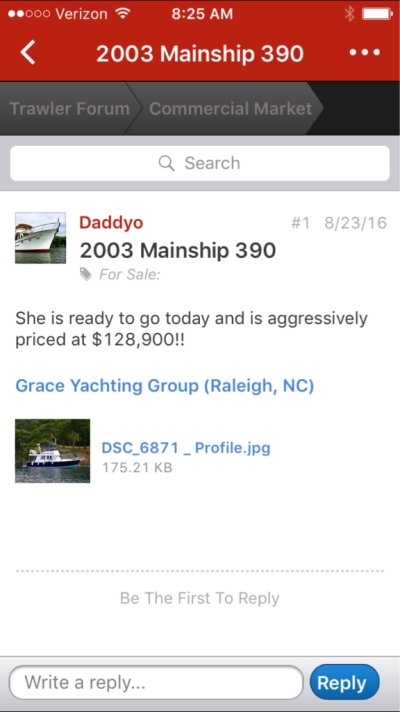Roger Long
Senior Member
I think (hope) our summer long trawler search is coming to an end. We just returned from a 2000 mile goose chase from Albany NY to Savannah GA and Patsy has been asking me, "Why do all these boats we are looking at have so many problems?" Answer: Because we are not in the $200 K market.
We spent the day looking at a Gulfstar 43 which, although a 1975 boat, is very much what I had in mind when thinking about $200 K boats. It has always been in freshwater, stored in a heated shed, and was restored by a professional captain with evidently a touch of OCD. Not a hint of water stain or water intrusion anywhere inside except a little wrinkle in the veneer next to the door. Neat as a pin. Decks solid.
One engine was out of commission as the FW water pump was sent out for rebuild, not because of failure but just slightly elevated coolant temps. So we haven't gotten to sea trials yet. The yard didn't want to move the boat to the lift on one engine and the workboat was unavailable for some unknown reason. So, we are waiting on haulout as well.
The only flaw in the ointment was when I got to the Onan 7.5MDJE generator. It started right up and ran well but, when I went into inspect it, water was dripping steadily from the RW pump through a plug fitting. I expect that will be easy to fix. However, the drip pan was full to overflowing with oil and there was oil and well soaked oil pads in the bilge.
I've ordered a full machinery survey but, for planning purposes since we have to return to Albany pending arrival of the engine pump next week, I would appreciate any Onan owner's opinions about what we might be facing with this generator. Is there a common source of oil leaks on this model? It is a startling flaw on what otherwise seems like a perfect boat for us at a very good price.
We spent the day looking at a Gulfstar 43 which, although a 1975 boat, is very much what I had in mind when thinking about $200 K boats. It has always been in freshwater, stored in a heated shed, and was restored by a professional captain with evidently a touch of OCD. Not a hint of water stain or water intrusion anywhere inside except a little wrinkle in the veneer next to the door. Neat as a pin. Decks solid.
One engine was out of commission as the FW water pump was sent out for rebuild, not because of failure but just slightly elevated coolant temps. So we haven't gotten to sea trials yet. The yard didn't want to move the boat to the lift on one engine and the workboat was unavailable for some unknown reason. So, we are waiting on haulout as well.
The only flaw in the ointment was when I got to the Onan 7.5MDJE generator. It started right up and ran well but, when I went into inspect it, water was dripping steadily from the RW pump through a plug fitting. I expect that will be easy to fix. However, the drip pan was full to overflowing with oil and there was oil and well soaked oil pads in the bilge.
I've ordered a full machinery survey but, for planning purposes since we have to return to Albany pending arrival of the engine pump next week, I would appreciate any Onan owner's opinions about what we might be facing with this generator. Is there a common source of oil leaks on this model? It is a startling flaw on what otherwise seems like a perfect boat for us at a very good price.


